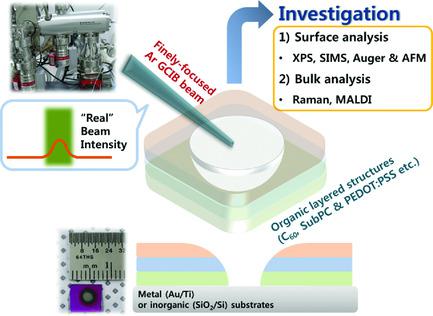当前位置:
X-MOL 学术
›
Adv. Mater. Interfaces
›
论文详情
Our official English website, www.x-mol.net, welcomes your
feedback! (Note: you will need to create a separate account there.)
Fabrication of Bevel Structures by Means of the Spatial Gradient of Ion Dose in Ar Gas Cluster Ion Beam and Its Unique Characteristics
Advanced Materials Interfaces ( IF 4.3 ) Pub Date : 2018-10-11 , DOI: 10.1002/admi.201800825 Dong‐Jin Yun 1 , Youngsik Shin 1 , Chang Hoon Jung 1 , Jae Cheol Lee 1 , Sunjung Byun 1 , JaeGwan Chung 1 , Sung Heo 1 , Seong Heon Kim 1
Advanced Materials Interfaces ( IF 4.3 ) Pub Date : 2018-10-11 , DOI: 10.1002/admi.201800825 Dong‐Jin Yun 1 , Youngsik Shin 1 , Chang Hoon Jung 1 , Jae Cheol Lee 1 , Sunjung Byun 1 , JaeGwan Chung 1 , Sung Heo 1 , Seong Heon Kim 1
Affiliation

|
For the accurate characterization of organic layered structures, a novel methodology to fabricate the bevel structure is suggested by utilizing the argon cluster ion‐beam sputtering (Ar GCIB), namely, little chemical damage to the organic material and a spatial gradient of ion dose in the sub‐millimeter range. The Ar GCIB sputtering settings are elaborately tuned on the basis of the Faraday/target current, and its optimization condition for preparing the bevel structure is determined. As a standard sample, an organic bevel structure is manufactured from the organic layered structure of C60/boron subphthalocyanine chloride/poly(3,4‐ethylenedioxythiophene):poly(styrenesulfonate) films, and their molecular distributions and chemical/electronic structures are investigated using various analytical techniques, including X‐ray photoelectron spectroscopy, secondary ion mass spectrometry, Auger electron spectroscopy, Raman spectroscopy, and matrix‐free ultraviolet‐laser desorption/ionization. Every experimental result demonstrates clearly that the bevel structure prepared by the method keeps its original molecular distribution and chemical structure. On the contrary, conventional etching techniques such as Ar+ ion beam, focused ion beam, and ion milling cause critical distortion in chemical information without exception. Ultimately, the suggested method, a unique way to prepare a damage‐free organic bevel structure, widens the availability of analytical techniques that have limitations in spatial or depth resolution.
中文翻译:

利用氩气团簇离子束中离子剂量的空间梯度制备斜面结构及其独特特性
为了准确表征有机层状结构,提出了一种利用氩簇离子束溅射(Ar GCIB)来制造斜面结构的新方法,即对有机材料的化学损伤很小,并且离子剂量的空间梯度很小。亚毫米范围。在法拉第/目标电流的基础上精心调整了Ar GCIB溅射设置,并确定了其准备斜角结构的最佳条件。作为标准样品,由C 60的有机层状结构制成有机斜面结构/硼亚酞菁氯化硼/聚(3,4-乙撑二氧噻吩):聚(苯乙烯磺酸盐)薄膜及其分子分布和化学/电子结构,采用多种分析技术进行了研究,包括X射线光电子能谱,二次离子质谱,俄歇电子光谱,拉曼光谱和无基质紫外激光解吸/电离。每个实验结果清楚地表明,通过该方法制备的斜面结构保持其原始的分子分布和化学结构。相反,传统的蚀刻技术,例如Ar +离子束,聚焦离子束和离子铣削无一例外地导致化学信息严重变形。最终,建议的方法是一种制备无损有机斜面结构的独特方法,从而扩大了在空间或深度分辨率方面有局限性的分析技术的可用性。
更新日期:2018-10-11
中文翻译:

利用氩气团簇离子束中离子剂量的空间梯度制备斜面结构及其独特特性
为了准确表征有机层状结构,提出了一种利用氩簇离子束溅射(Ar GCIB)来制造斜面结构的新方法,即对有机材料的化学损伤很小,并且离子剂量的空间梯度很小。亚毫米范围。在法拉第/目标电流的基础上精心调整了Ar GCIB溅射设置,并确定了其准备斜角结构的最佳条件。作为标准样品,由C 60的有机层状结构制成有机斜面结构/硼亚酞菁氯化硼/聚(3,4-乙撑二氧噻吩):聚(苯乙烯磺酸盐)薄膜及其分子分布和化学/电子结构,采用多种分析技术进行了研究,包括X射线光电子能谱,二次离子质谱,俄歇电子光谱,拉曼光谱和无基质紫外激光解吸/电离。每个实验结果清楚地表明,通过该方法制备的斜面结构保持其原始的分子分布和化学结构。相反,传统的蚀刻技术,例如Ar +离子束,聚焦离子束和离子铣削无一例外地导致化学信息严重变形。最终,建议的方法是一种制备无损有机斜面结构的独特方法,从而扩大了在空间或深度分辨率方面有局限性的分析技术的可用性。











































 京公网安备 11010802027423号
京公网安备 11010802027423号